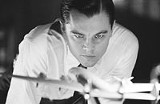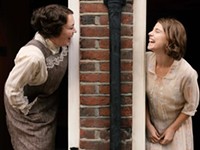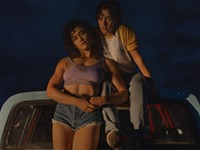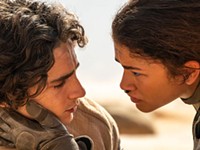[
{
"name": "500x250 Ad",
"insertPoint": "5",
"component": "15667920",
"parentWrapperClass": "",
"requiredCountToDisplay": "1"
}
]
His profound love of the cinema and his broad knowledge of its history, displayed brilliantly in his several documentaries on film, obviously provide a major inspiration for Martin Scorsese's work. Despite a deserved reputation for originality, he has committed both sequels and remakes, and of course, happily acknowledges his debt to the dense and glittering Hollywood tradition.
In a sense, then, The Aviator constitutes an almost inevitable result of his own personal and professional interests. It also continues some of his most recent work, recalling the narrative, structure, and even the characterization of Gangs of New York.
Not surprisingly, The Aviator, a biopic about a controversial icon of the great studio era, looks very like a contemporary version of a classic Hollywood story about Hollywood, a film about films. Its appearance also suggests that somewhere deep inside his psyche Martin Scorsese yearns to make an old-fashioned, big studio flick recalling the Golden Age of American cinema.
He sets the panoramic story of some 20 years in the life of the multimillionaire aviation pioneer, business tycoon, and film mogul Howard Hughes (Leonardo DiCaprio) against the background of the film industry in the period from the late 1920s through the late 1940s, encompassing some of the most tumultuous years in American history.
Scorsese clearly intends to portray Hughes as the hero of an American epic, a larger-than-life figure whose enormous wealth allowed him to indulge himself on a grand scale in a number of public arenas.
Hughes, who inherited a large, profitable manufacturing company at the age of 18, fell in love with aviation and motion pictures, combining the two in his famous World War I film Hell's Angels. The most entertaining footage in this immensely long movie, in fact, involves the making of that spectacular work, which cost many millions of dollars and the lives of some of its pilots.
Scorsese otherwise concentrates on Hughes's infatuation with flying, which led him to design the fastest airplane in the world as well as a notorious giant wooden cargo plane, an airborne lumberyard dubbed the Spruce Goose. Hughes also established a number of speed records, including one for a circumnavigation of the globe, and in the process of pursuing those records, suffered serious injuries in a plane crash.
Much of the film also deals with Hughes's financial ambitions, which led him to purchase an airline and compete with Juan Trippe (Alec Baldwin) of Pan American Airlines over postwar passenger routes to Europe, involving him in Congressional hearings and political fixing.
The real subject of the film, however, remains Scorsese's fascination with the Hollywood of the past, which allows him to employ a number of well known performers playing some of the famous stars of the time. The movie returns again and again to the Coconut Grove, where Hughes dines regularly (and austerely) and bumps into such luminaries as the drunk and obnoxious Errol Flynn (Jude Law).
Although germ phobic and obsessive compulsive, disliking human contact, Hughes managed to achieve intimacy with a number of Hollywood actresses, including Faith Domergue (Kelli Garner), Ava Gardner (Kate Beckinsale), and above all, Katherine Hepburn (Cate Blanchett).
For Scorsese the affair with Hepburn, who possessed more than enough self-confidence to stand up to the brash playboy, dominates all the other relationships in the movie. Unfortunately, because of the manifold failures of the two actors, including an utter lack of sexual chemistry, the scenes between them tend to turn unintentionally comical.
DiCaprio lacks any hint of masculine appeal and Blanchett conducts an impersonation of Hepburn that constantly and painfully verges on caricature (Scorsese might have done better to hire Martin Short, who does a great Hepburn, though he's neither tall enough nor masculine enough for the part).
The performance of DiCaprio, following on the heels of his dreadful behavior in the awful Gangs of New York, continues the puzzle of Scorsese's recent judgments. In an apparent attempt to look serious, DiCaprio maintains one facial expression throughout, tightening his lips and frowning severely, and uses a set of repeated tics and verbal behaviors to indicate an increasing lunacy. The static quality of his and other performances matches the essentially static nature of the narrative, which despite its flying sequences and its 20 or so years of history, seems to stand still in the same spot for most of its length, another hangover from the stagnation and repetition of Gangs of New York.
The picture indicates that Martin Scorsese not only succumbed to the lure of a big studio picture, but that he also accepted the conditions of old Hollywood. In The Aviator he cast big names, depended heavily on a single artificial set, fell back on awkward and antiquated narrative gimmicks, and settled for work with more hype than quality.
Either he's lost his touch or he's sold out, both of which constitute a damned shame.
The Aviator (PG-13), starring Leonardo DiCaprio, Cate Blanchett, Kate Beckinsale, John C. Reilly, Alec Baldwin; written by John Logan; directed by Martin Scorsese. Cinemark Tinseltown, Loews Webster, Pittsford Plaza Cinema, Regal Culver Ridge, Regal Eastview, Regal Greece Ridge, Regal Henrietta
Latest in Movie Reviews
More by George Grella
-

Film Review: "Cake"
Jan 26, 2015 -
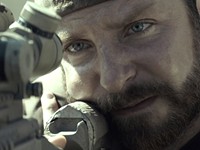
Film Review: "American Sniper"
Jan 19, 2015 -
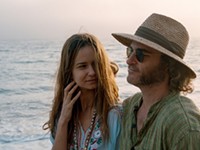
Film Review: "Inherent Vice"
Jan 12, 2015 - More »
